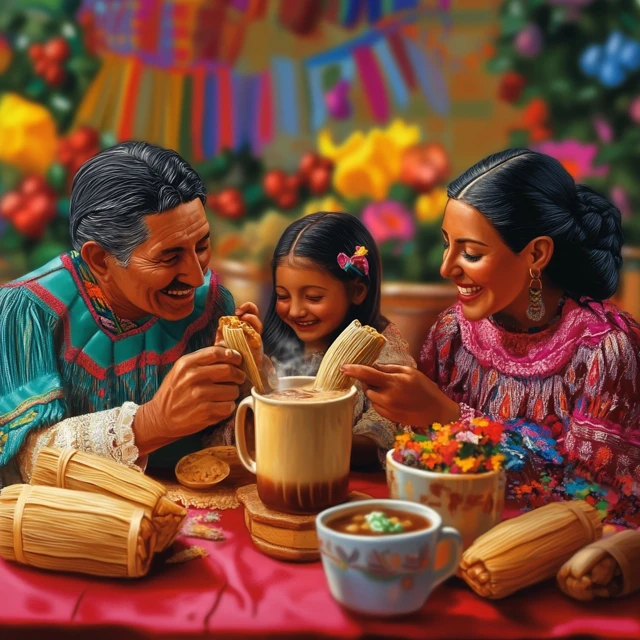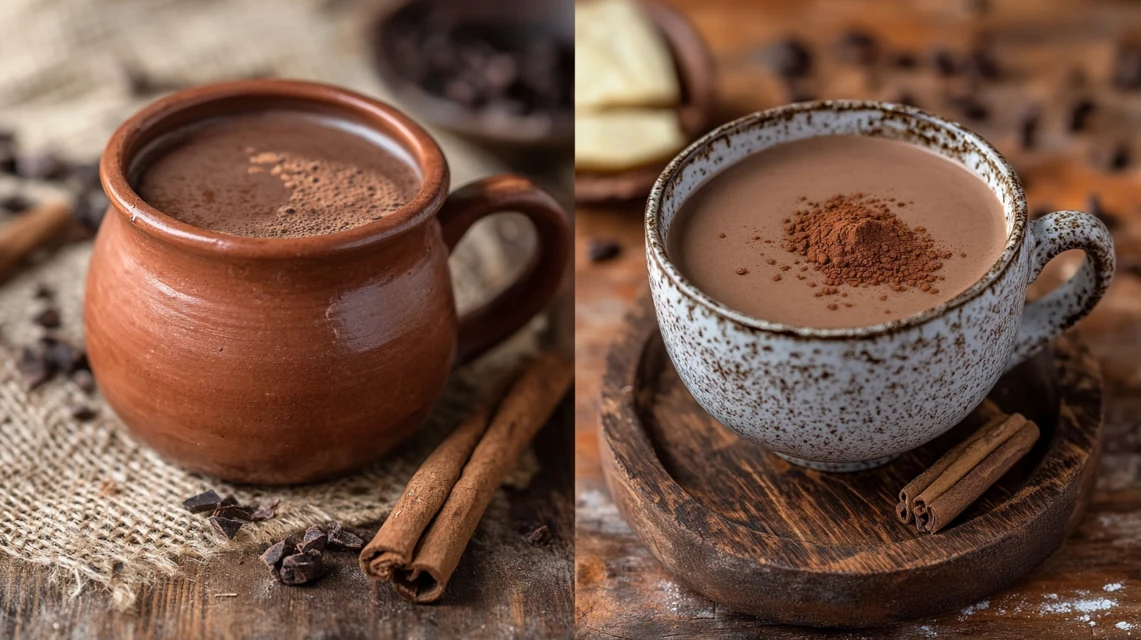Hot chocolate and champurrado are two beloved warm beverages that share a deep connection to Mexican culinary traditions. However, they are distinct in flavor, texture, and preparation. While both drinks are comforting and delicious, understanding their differences will help you appreciate what makes each one unique.
Understanding Hot Chocolate and Champurrado
Both hot chocolate and champurrado have their roots in Mesoamerican culture and are made with similar foundational ingredients, but their purpose and characteristics vary widely.
What Is Hot Chocolate?
Hot chocolate is a sweetened, cocoa-based beverage that has become a favorite around the world. It can range from simple powdered mixes to artisanal versions made with high-quality chocolate.
Key Features of Hot Chocolate:
- Base Ingredients: Typically made with milk, cocoa powder or chocolate tablets, and sugar.
- Flavor Profile: Sweet, creamy, and rich, with optional spices like cinnamon or vanilla for added depth.
- Versatility: Enjoyed plain or with toppings like whipped cream, marshmallows, or chocolate shavings.
Hot chocolate is a go-to drink for cozy moments, especially during the winter months, offering warmth and sweetness in every sip.
check out this https://eassyrecipes.com/category/breakfast/
What Is Champurrado?
Champurrado is a traditional Mexican drink that is thicker and heartier than hot chocolate, often considered a meal accompaniment rather than just a beverage. It is a type of atole, a masa-based drink, that incorporates chocolate as a main ingredient.
Key Features of Champurrado:
- Base Ingredients: Made with masa harina (corn flour), water or milk, Mexican chocolate, and sweeteners like piloncillo (unrefined cane sugar).
- Flavor Profile: Sweet, earthy, and slightly spiced, with a rich, comforting texture.
- Thick Consistency: The use of masa harina gives champurrado its signature thickness, making it almost like a drinkable pudding.
Traditionally served with tamales or as part of a festive meal, champurrado is both nourishing and flavorful.
Shared Origins and Ingredients
Hot chocolate and champurrado share a common origin in Mesoamerican cultures, particularly among the Aztecs and Mayans, who first cultivated cacao and used it to create a beverage called xocoatl. This drink was unsweetened, bitter, and often spiced with chili.
Common Ingredients:
- Cacao: Both drinks feature chocolate, though the form and preparation differ.
- Sweeteners: While modern hot chocolate often uses refined sugar, champurrado typically uses piloncillo, which adds a deeper, caramel-like sweetness.
- Spices: Cinnamon is a common addition in both beverages, providing warmth and complexity.
Although they share these roots, the evolution of hot chocolate and champurrado has led to unique differences in how they are prepared and enjoyed.
Key Differences Between Hot Chocolate and Champurrado

While hot chocolate and champurrado share similarities, their distinctions make them suitable for different occasions and preferences.
Texture and Consistency
The most noticeable difference between the two drinks lies in their texture.
- Hot Chocolate:
- Smooth and creamy, with a liquid consistency.
- Designed to be sipped, making it a lighter option compared to champurrado.
- Champurrado:
- Thick and hearty, thanks to the masa harina used in its preparation.
- The texture is more substantial, making it feel like a cross between a drink and a dessert.
The thick consistency of champurrado gives it a more filling quality, making it a popular choice for breakfast or a midday snack.
Preparation Methods
The process of making hot chocolate and champurrado also sets them apart.
- Hot Chocolate Preparation:
- Heat milk or water and stir in cocoa powder, chocolate tablets, or syrup until dissolved.
- A molinillo (a traditional wooden whisk) is often used to froth Mexican hot chocolate for a creamy top layer.
- Champurrado Preparation:
- Dissolve masa harina in water or milk to create a smooth base.
- Add chocolate, piloncillo, and spices, then simmer until the mixture thickens.
- A molinillo may also be used to blend and froth the drink, enhancing its texture.
The preparation of champurrado involves more steps and ingredients, reflecting its role as a heartier, more complex beverage.
check out this https://eassyrecipes.com/category/breakfast/
Typical Ingredients
The choice of ingredients further highlights the differences between hot chocolate and champurrado.
- Hot Chocolate Ingredients:
- Milk or water
- Cocoa powder, chocolate tablets, or syrup
- Sugar
- Optional spices like cinnamon or vanilla
- Champurrado Ingredients:
- Masa harina (corn flour)
- Water or milk
- Mexican chocolate tablets
- Piloncillo (unrefined cane sugar)
- Cinnamon and other optional spices
The use of masa harina in champurrado not only thickens the drink but also adds a distinct corn flavor, tying it to Mexico’s culinary heritage.
Cultural and Regional Significance

Hot chocolate and champurrado are deeply embedded in Mexican traditions, playing distinct roles in celebrations, rituals, and daily life. Their cultural and regional significance adds layers of meaning to these comforting drinks, making them much more than just beverages.
The Role of Hot Chocolate in Mexican Traditions
Hot chocolate has long been a beloved drink in Mexican culture, symbolizing warmth, hospitality, and tradition. Its history dates back to ancient Mesoamerican civilizations, where cacao was considered sacred.
Cultural Roots:
- Aztec and Mayan Origins:
- The Aztecs and Mayans revered cacao as a divine gift and used it in rituals and as currency.
- The first hot chocolate drinks, called xocoatl, had no sugar and used spices, making them more like today’s Mexican hot chocolate than the sweet kinds most people drink now.
- Colonial Influence:
- Spanish colonizers introduced sugar and milk to cacao-based drinks, creating the sweeter, creamier hot chocolate we know today.
Modern Traditions:
- Breakfast Staple: Mexican hot chocolate is often enjoyed in the morning, paired with pan dulce (sweet bread) or churros.
- Festive Gatherings: It is a favorite during Christmas and Día de los Muertos (Day of the Dead), where it brings comfort and joy to family celebrations.
- Symbol of Hospitality: Serving hot chocolate to guests is a warm gesture, reflecting the Mexican value of welcoming others.
Hot chocolate’s versatility and rich history make it a cherished part of both everyday life and special occasions.
check out this https://eassyrecipes.com/category/breakfast/
Champurrado as a Festive Beverage
Champurrado holds a special place in Mexican celebrations, particularly during the holiday season and other significant events. Its thick, hearty texture makes it ideal for pairing with traditional foods like tamales.
Key Occasions for Champurrado:
- Día de los Muertos:
- Families make champurrado for their dead loved ones’ altars, giving them warmth and food.
- It is also served during gatherings, where families share memories of those who have passed.
- Las Posadas:
- During the Christmas season, champurrado is a staple at Las Posadas, a nine-day celebration leading up to Christmas.
- It is served alongside tamales and other festive foods, bringing comfort to participants as they reenact Mary and Joseph’s search for shelter.
- Street Festivals:
- Vendors often sell champurrado at street markets and festivals, offering a warm, satisfying drink to visitors.
- Its rich flavor and filling texture make it a popular choice for early mornings and late evenings.
Champurrado’s presence at these events underscores its importance as a drink that nourishes both the body and the spirit.
When to Choose Hot Chocolate or Champurrado
Hot chocolate and champurrado are both tasty and warming, but each has special features that make it better for different times and likes.
Choose Hot Chocolate When:
- You Want a Light Drink: Hot chocolate’s smooth, liquid consistency makes it a lighter option compared to champurrado.
- You’re Pairing with Desserts: Its mild sweetness complements pastries and cookies without overwhelming the palate.
- You’re in a Hurry: Hot chocolate is quicker to prepare, making it a convenient choice for busy mornings or quick snacks.
Choose Champurrado When:
- You Need a Hearty Drink: The thick, filling texture of champurrado makes it almost like a meal in itself.
- It’s a Festive Occasion: Champurrado’s association with holidays and celebrations makes it perfect for special gatherings.
- You Want to Explore Tradition: Its use of masa harina and piloncillo ties champurrado to Mexico’s rich culinary heritage, offering a unique cultural experience.
Both drinks have their own charm, and choosing one over the other depends on the context and personal preference.
FAQs About Hot Chocolate and Champurrado
Hot chocolate and champurrado are staples of Mexican cuisine, each offering unique flavors and cultural significance. Here are some frequently asked questions to help clarify their differences and importance.
What’s the Difference Between Mexican Hot Chocolate and Regular Hot Chocolate?
Mexican hot chocolate and regular hot chocolate differ in flavor, ingredients, and preparation.
Mexican Hot Chocolate:
- Ingredients: Mexican hot chocolate uses chocolate tablets made with cocoa, unrefined sugar, and cinnamon, often with a grainier texture.
- Spices: It is spiced with ingredients like cinnamon and occasionally chili powder, creating a warm and slightly spicy profile.
- Texture: The use of a molinillo (a traditional wooden whisk) froths the drink, giving it a creamy, foamy top.
Regular Hot Chocolate:
- Ingredients: Typically made with cocoa powder, sugar, and milk, resulting in a smoother texture.
- Flavor: It is sweeter and lacks the complexity of spices found in Mexican hot chocolate.
- Preparation: Often mixed with a spoon or whisk, it doesn’t achieve the same frothy texture as the Mexican version.
The spices and frothiness of Mexican hot chocolate make it a richer and more aromatic experience compared to regular hot chocolate.
What Is the Mexican Name for Hot Chocolate?
In Mexico, hot chocolate is commonly referred to as chocolate caliente, which simply translates to “hot chocolate.” However, when prepared in the traditional Mexican style, it often incorporates unique elements such as:
- Chocolate Tablets: Brands like Abuelita and Ibarra are popular choices for making Mexican hot chocolate.
- Cultural Connection: Chocolate caliente is often enjoyed during family gatherings, holidays, and celebrations.
The term chocolate caliente highlights the drink’s connection to Mexican traditions while distinguishing it from other types of hot chocolate.
What’s the Difference Between Hot Chocolate and Hot Chocolate?
While this question may seem repetitive, it often arises when people want to compare Mexican hot chocolate to other variations of the drink, such as those from Europe or the United States.
Mexican Hot Chocolate:
- Includes spices like cinnamon and chili powder.
- Has a slightly grainy texture due to unrefined sugar and ground cocoa nibs.
- Prepared using a molinillo for a frothy finish.
European or American Hot Chocolate:
- Typically smoother and sweeter.
- Made with refined cocoa powder or syrups.
- Often topped with whipped cream or marshmallows rather than frothy milk.
Each type of hot chocolate reflects the culinary traditions of its region, offering unique flavors and textures.
What Does Champurrado Mean in English?
Champurrado translates roughly to “thickened drink” in English, reflecting its defining characteristic: a thick consistency achieved with masa harina (corn flour). This traditional beverage is a type of atole, a family of masa-based drinks popular in Mexico.
Key Features of Champurrado:
- Ingredients: Made with masa harina, piloncillo, Mexican chocolate, and cinnamon.
- Cultural Significance: Often enjoyed during holidays, festivals, and family gatherings.
- Texture: Its thickness makes it more filling than hot chocolate, almost like a drinkable dessert.
The name champurrado highlights the drink’s hearty texture and its deep roots in Mexican culinary traditions.
Conclusion
People all over the world love hot chocolate and champurrado. In fact, these two drinks really show what makes Mexican cooking so good. First, Mexican hot chocolate, or chocolate caliente, stands out because it uses bold spices and has tiny bubbles on top. Meanwhile, champurrado gets its thick and filling texture from corn. As a result, both drinks play a big part in Mexican life, showing up at fun parties and everyday meals.
Moreover, when you learn about what makes these drinks different from each other, you start to see why their tastes, how they feel in your mouth, and their stories are so special. So whether you’re drinking a bubbly cup of Mexican hot chocolate or tasting the rich, thick champurrado, you’ll get to know a piece of Mexico’s amazing food history.

